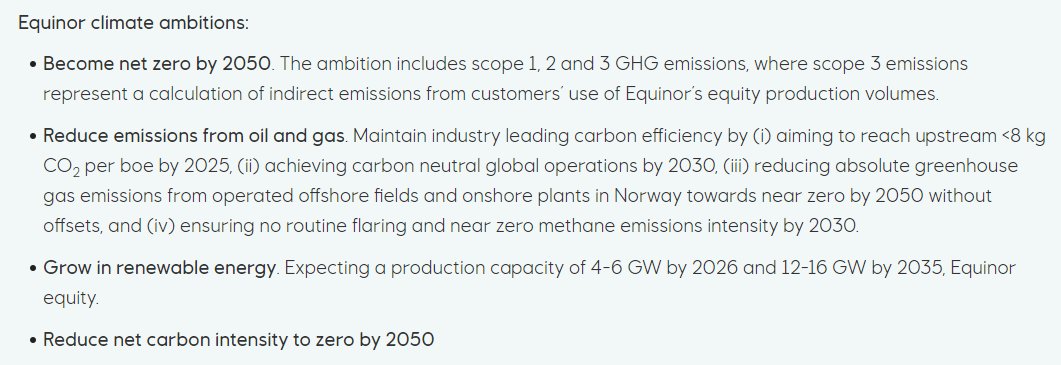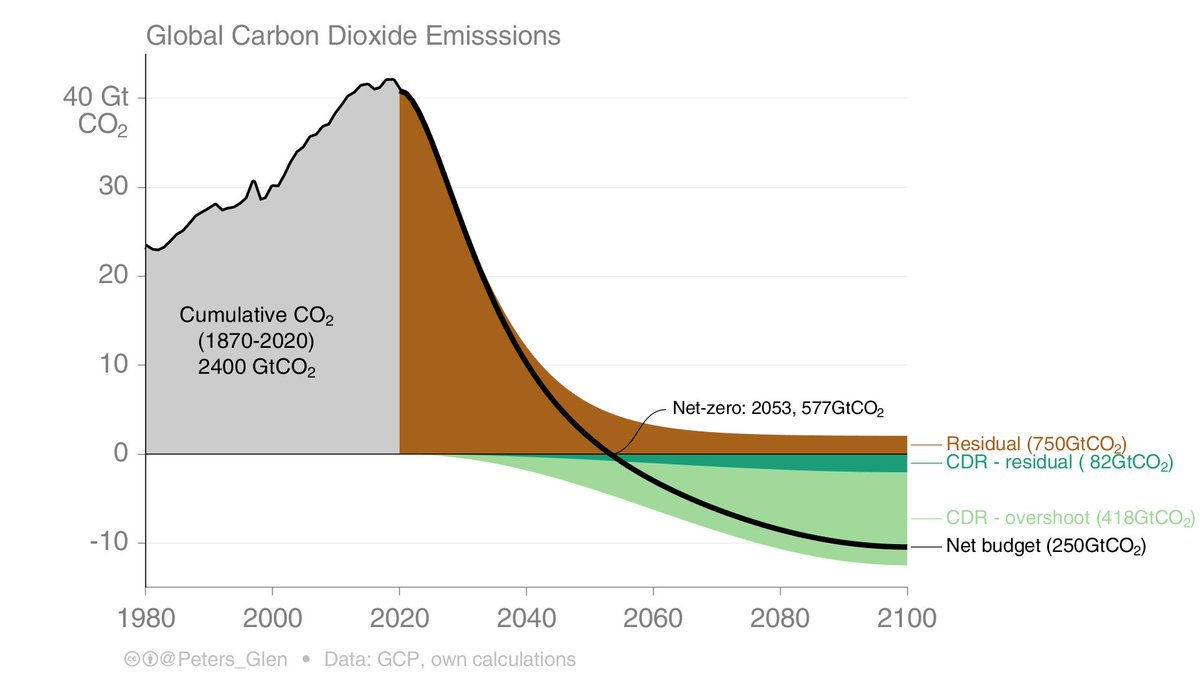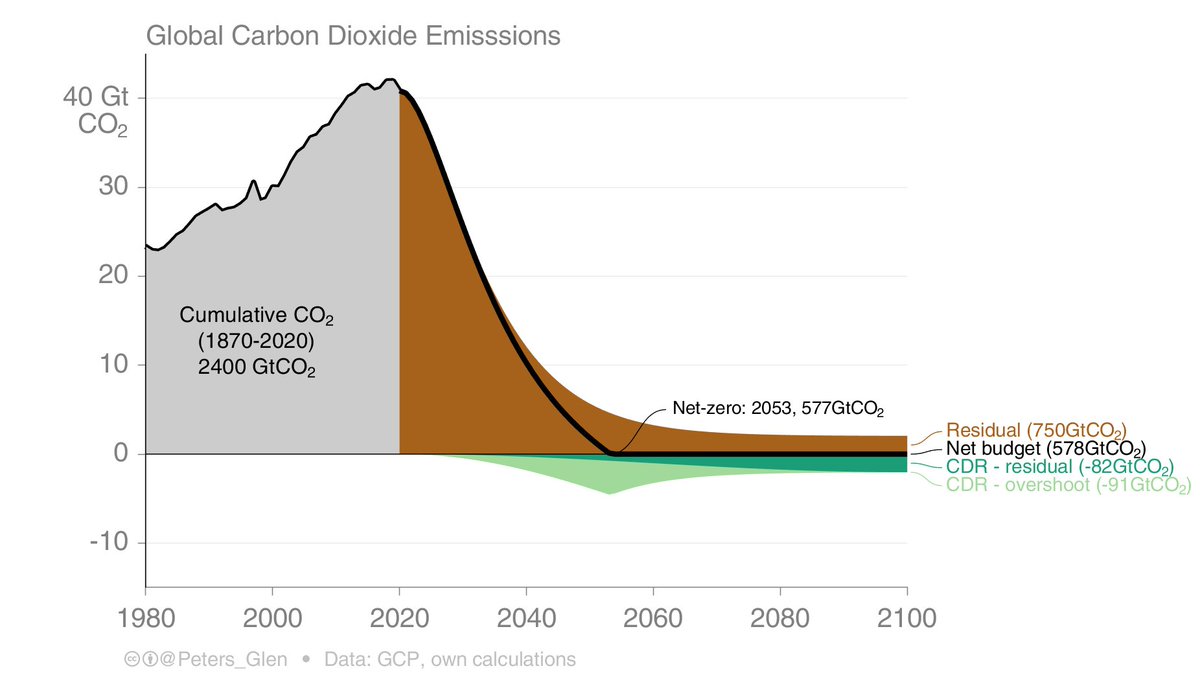
THREAD: Does the @IEA 1.5°C scenario (Net-Zero Emissions 2050) need carbon dioxide removal?
See my presentation at #WEOWeek or read this thread...
Video:
Slides: www2.slideshare.net/GlenPeters_CIC…
See my presentation at #WEOWeek or read this thread...
Video:
Slides: www2.slideshare.net/GlenPeters_CIC…

2. Background: Most scenarios have positive emissions (brown) & carbon dioxide removal (green) to get a net (black).
Because of hard-to-mitigate sectors, CDR is needed to:
1. Offset residual emissions
2. Bring temperatures down (optional)
cicero.oslo.no/no/posts/klima…
Because of hard-to-mitigate sectors, CDR is needed to:
1. Offset residual emissions
2. Bring temperatures down (optional)
cicero.oslo.no/no/posts/klima…

3. (bonus extra). It is not necessary to have so much CDR that it causes temperature overshoot (light green in previous figure) because of net-negative emissions.
Here is a scenario which just goes to net-zero, & has enough CDR to stay there.
Here is a scenario which just goes to net-zero, & has enough CDR to stay there.

4. The IEA net-zero scenarios (2050 for 1.5°C, 2070 for ~1.65°C) stop when they get to zero.
Questions:
* What happens post net-zero?
* When does CDR start being deployed?
* How much CDR is used at net-zero?
The focus on NZE2050 has been the period 2020-2030 (which is critical)
Questions:
* What happens post net-zero?
* When does CDR start being deployed?
* How much CDR is used at net-zero?
The focus on NZE2050 has been the period 2020-2030 (which is critical)

5. When compared to 1.5°C scenarios with no & low overshoot assessed for the #IPCC #SR15, the NZE2050 scenario is rather consistent to 2050. But, all the IPCC scenarios go below zero (net negative). Since they have to offset residual emissions, these scenarios have even more CDR! 

6. (bonus extra) Here are the same scenarios for the IPCC 'lower 2°C' category (66% chance below 2°C in 2100). The IEA SDS is completely consistent with these scenarios, which leads to warming of the order ~1.65°C (depending on non-CO₂ emissions & climate response) 

7. The IEA Energy Technology Perspectives, details the SDS further. The residual emissions in 2070 are ~3GtCO₂ in 2070, meaning CDR of ~3GtCO₂ is needed for net-zero.
The SDS mainly gets CDR from bioenergy with carbon capture & storage (BECCS).
iea.org/reports/energy…
The SDS mainly gets CDR from bioenergy with carbon capture & storage (BECCS).
iea.org/reports/energy…

8. Piecing together the data from several reports, the BECCS pathway in SDS is much lower than in comparable scenarios assessed by the IPCC.
The SDS has quite slow build up of CDR (vs IPCC):
* Starts 2030
* ~0.095 GtCO₂ in 2040
* ~0.25 GtCO₂ in 2050
* ~3 GtCO₂ in 2070
The SDS has quite slow build up of CDR (vs IPCC):
* Starts 2030
* ~0.095 GtCO₂ in 2040
* ~0.25 GtCO₂ in 2050
* ~3 GtCO₂ in 2070

9. (bonus extra) Here is BECCS in the SDS compared to the IPCC 1.5°C scenarios. They have more BECCS, but not hugely different to the 2°C scenarios (ie, BE is already maxed in 2°C scenarios).
What will BECCS be like in the IEA 1.5°C NZE2050? We don't know yet...
What will BECCS be like in the IEA 1.5°C NZE2050? We don't know yet...

10. What I would like to see in WEO2021:
* Fully detail NZE2050 to net-zero in 2050 (at least). How much coal, oil, gas, CDR, etc
* When does CDR scale up?
* Give some thoughts on post-2050 & scale of continued CDR
* Full assessment of CDR potential (scale & rate of deployment)
* Fully detail NZE2050 to net-zero in 2050 (at least). How much coal, oil, gas, CDR, etc
* When does CDR scale up?
* Give some thoughts on post-2050 & scale of continued CDR
* Full assessment of CDR potential (scale & rate of deployment)
11. You can find my presentation here
www2.slideshare.net/GlenPeters_CIC…
Or take an hour to watch the presentations with @Laura_Cozzi_: 10 minutes on NZE2050 (@TofMcGlade, @djgcrow), then 4x 5 minutes inputs from @sladislaw, Ed Webber (BEIS), Zou Ji (China)
www2.slideshare.net/GlenPeters_CIC…
Or take an hour to watch the presentations with @Laura_Cozzi_: 10 minutes on NZE2050 (@TofMcGlade, @djgcrow), then 4x 5 minutes inputs from @sladislaw, Ed Webber (BEIS), Zou Ji (China)
• • •
Missing some Tweet in this thread? You can try to
force a refresh















